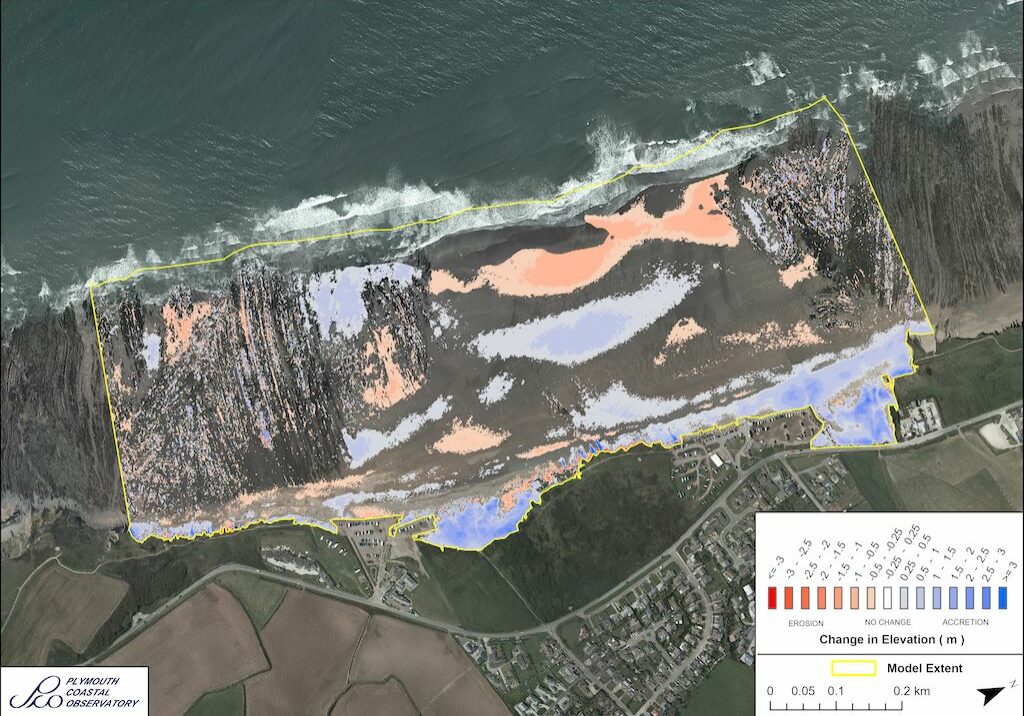
Widemouth Bay is a west facing wide beach in north Cornwall. A small stream flows onto the northern side of the beach, the catchment of which is shallow sloped and largely agricultural in nature. The cliffs of Widemouth are steep and low lying. The character of the geology changes with southward progression, marking a transition from the older more resilient rocks of the Crackington Formation, to the younger and less resilient rocks of the Bude Formation.
During high water a series of shallow headlands and rocky outcrops separate the bay into smaller areas. As the tide drops, the beach opens up, making it possible to walk the 2km from Wanson Mouth to the south to Salthouse Beach to the north.
The fringes of Widemouth Bay are dominated by rocky platforms, which cover much of the intertidal area. Only about 1km of the intertidal area is sandy, the sediment of which is coarse in nature and dark in colour, owing to the high proportion of lithic (bedrock) material. Though the uppershore of Widemouth can sometimes be sandy, it is more often covered by pebbles and cobbles.
To either side of the cliffs at the centre of the beach, dunes have formed. Though some parts of the dune have naturally rolled back, both the northern and southern edges have been developed to provide parking and amenities to accommodate beach visitors. Much of the remaining development associated with the site has taken place to the east of the local road (called Marine Drive), which allows space for the beach and dunes to rollback.


Coastal Change
The coastline of Cornwall is an ever-changing environment. It is energetic, dynamic, never still and changes with each wave and each tidal cycle. Some of the changes we see are gradual and barely noticeable, whilst others, such as rockfalls, happen suddenly and often shockingly.
From one visit to the next it can sometimes be difficult to see how a beach and dune system has changed, but information has been collected, and is being collected through the Making Space for Sand project, to help us better understand how the coastline is changing. The purpose of this section of the website is to understand each location has changed over time, how it could change in the future and understand the policies that influence how we can respond to these changes.
Shoreline Management Plans (SMP)
The Shoreline Management Plan (SMP) is a strategic planning and management assessment tool that helps identify and measure the risk associated coastal erosion and coastal flooding. The document makes a number of policy recommendations over short, medium and long term timeframes setting out a strategic approach to managing the built, natural and historic environments associated with the coastline. Within SMP there are four policy approaches which have been assigned to stretches of coastlines. The four policies are: No Active Intervention (NAI), Hold the Line (HTL), Managed realignment (MR), and Advance the line (ATL).
Widemouth Bay sits within Policy Development Zone 16 (PDZ16), in Management Area 39 (MA39), within Policy Units (PU) 39.1, 39.2 and 39.3. The policy recommendations for these policy units are detailed in the table below and the SMP can be accessed through the Cornwall Council website.
Use your touchscreen
to scroll the below table
| Policy Unit | SMP2 Policy Plan | ||||
| 2025 | 2055 | 2105 | Comment | ||
| 39.1 | Undefended Cliffs
Main Policy Sub Policy
|
NAI DnD |
NAI DnD |
NAI DnD |
Allow natural evolution to occur to support conservation of designated features. This will also allow this area to continue to provide an important sediment source to the frontage. |
| 39.2 | Black Rock / South Widemouth
Main Policy Sub Policy
|
MR RnR |
MR NF |
NAI LAO |
Realignment efforts to re-establish naturally functioning dune system – provide improved natural defence and buffer zone, improve habitat status. Roll-back may require support from land use planning system and consider potential implications for the transport network. Long term intent for the unit is NAI due to creation of a functioning dune system providing necessary defence. |
| 39.3 | North Widemouth
Main Policy Sub Policy
|
MR RnR
|
MR NF |
NAI LAO |
Realignment efforts to re-establish naturally functioning dune system – provide improved natural defence and buffer zone, improve habitat status. Roll-back may require support from land use planning system and consider potential implications for the transport network. Long term intent for the unit is NAI due to creation of a functioning dune system providing necessary defence. |
| Key Main Policy: HTL - Hold the Line, A - Advance the Line, NAI – No Active Intervention, MR – Managed Realignment
Sub Policy: DnD – Do not Defend, RnR – Repair not Replace, NF - Natural Features, LAO – Local Activity Only |
|||||


National Coastal Erosion Risk Mapping (NCERM)
National Coastal Erosion Risk Mapping (NCERM) provides a baseline of coastal erosion, for the coastline of England, over short, medium and long-term timeframes. The data is based on the natural and defence characteristics of the coastline and provides rates of erosion at differing levels of confidence to help better plan for worse case scenarios. The data provided is for guidance and does not estimate the absolute location of the future coastline.
The basic NCERM lines show erosion estimates for the Short Term (ST-20 years), Medium Term (MT-50 years) and Long Term (LT- 100 years). The data is further categorised by probability: 05 is 5% probability (a 1 in 20 chance of being exceeded) Red Shading, 50 is 50% probability of being exceeded (a 1 in 2 chance of being either exceeded or not exceeded) Orange Shading and 95 is 95% probability (a 19 in 20 chance of being exceeded) Yellow Shading. Click the link below to access the Cornwall Council NCERM Mapping site read the about section then click on layers.
Historical Images of Widemouth Bay
Historical photographs provide a powerful insight into how the Cornish coastline has changed within the past Century. The Making Space for Sand project are working in collaboration with the Francis Frith collection and have been given permission to share historical images on a number of beaches considered within the project.
In looking back, we can better understand how the coastline has changed, helping us understand not only how the coastal fringe has developed but also the potential future changes that we my observe. When this is considered alongside forecasts of coastal erosion and sea level rise it will help enable us to better adapt to our changing coastline.
Image of Widemouth Bay from Salthouse Beach in c1955 (Courtesy of the Francis Frith collection) and in 2024
Image of Widemouth Bay from middle cliffs in c1960 (Courtesy of the Francis Frith collection) and in 2024


Modelling Coastal Change
Using data that has already been collected, combined with data collected through the Making Space for Sand project, a series of models will be carried out at each location. This will help us better understand how each location may respond to sea level rise and gain a deeper understanding of how coastal sediments move and behave.
The complexity of the modelling, and the data collection that helps inform it, means that modelling outputs will not be the same on all sites. Some locations will be more thoroughly investigated to understand more complex issues and provide data that can be more widely applied to other sites with similar characteristics.
As the project develops this section of the website will expand, sharing new reports and coastal change projections when they are produced.
LiDAR surveys, which are explained on the Data Modelling page, have been carried out by the South West Coastal Monitoring program at this location. The image shared here visualises where sand has eroded (areas shaded in red) and where it has built up (areas shaded in blue), between the LiDAR surveys carried out in 2003 and 2019. The darker the shade of red or blue the greater the amount of sand erosion or accumulation has been observed. The image helps visualise that beaches are areas that change shape over time and will continue to do so as sea levels rise.



Beach & Dune Ecology
Beaches and dunes represent an important transition between the marine environment and the terrestrial environment. This transition creates a range of special habitats and exposes a range of interesting features, which that can result in these spaces being highly designated and protected. The Making Space for Sand project will survey a number of dune systems. These surveys will help highlight how they may be changing, will identify rare species, will map invasive species, help us understand overall dune condition and identify potential constraints to improving their condition.
There are a range of designations that recognise a variety of different features. There are also a number of dunes systems where data has been collected to understand their habitat value. These are explored, on a site-by-site basis, in this part of the website.

Designations
Special Area of Conservation (SAC)
A Special Area of Conservation (SAC) is an internationally recognised designation with the aim of protecting habitats or species that are of European importance. Land with SACs is considered to be part of a network of high-quality conservation sites, and those considered to be most in need of conservation at a European level.
The Tintagel, Marsland and Clovelly SAC covers an area of approximately 2380.4 hectares and has been designated for a number of characteristics identified along its 60km of coastline. The coastline represents an extensive length of vegetated sea cliffs, fully exposed to Atlantic storms and therefore strongly maritime in character. Stretches of old sessile oak wood occur at various points along this section of coast, where the bryophyte (mosses, liverworts and hornworts) and lichen assemblages can be particularly rich.
Image of the High Cliffs of North Cornwall (Courtesy of Coralie Barrow)
Site of Special Scientific Interest (SSSI)
A Site of Special Scientific Interest or SSSI is a statutory conservation designation notified by Natural England denoting protection for biological and/or geological characteristics. The natural wildlife and geological features of SSSI’s are considered to be irreplaceable parts of the national heritage. These are protected in order to preserve their importance, and to prevent damage and development.
The Boscastle to Widemouth SSSI comprises of the 12 miles of coastline and hinterland between the two locations, covering an area of 639 hectares. The cliffs exhibit classic geological exposures of faulting, folding and the transition from the Crackington Formation (in the south) to Bude Formation (in the north). Outstanding biological interest includes the unique Dizzard Oak woodland, maritime heaths and intertidal zones.
Image of the zig-zag chevron folding cliffs at Millook Haven (Courtesy of Coralie Barrow)
Designated Cornwall National Landscape Area
From November 2023, all areas previously know as Areas of Outstanding Natural Beauty, or AONBs, were re-named National Landscape and in Cornwall became Cornwall National Landscape. However, the Management Plan still references the term AONB as this was formally adopted by Cornwall Council and cannot be amended until the next plan is produced.
Cornwall National Landscape areas are protected landscapes whose distinctive character and natural beauty are so outstanding that it is in the nation’s interest to safeguard them. As such they have been nationally designated by the same legislation as National Parks and have the same status and level of protection.
The Pentire Point to Widemouth section covers an area of 11,879 hectares, which is 12.3% of the total Cornwall National Landscape. The key landscape characteristic of this section is the coastline, which is craggy with dramatic contorted cliffs and folded slates, shales and volcanic rocks with some sandstone to the north.
Image of photographers at sunset at Trebarwith Strand (Courtesy of Myles Pinkney)
Marine Conservation Zone (MCZ)
A Marine Conservation Zone (MCZ) is a type of marine protected area, designated in English, Welsh and Northern Ireland territorial offshore waters, to protect a range of nationally important, rare or threatened marine habitats or species by halting or reversing damage and degradation caused by human activities.
The Hartland to Tintagel MCZ covers an area of 304km2 following the coastline along, along Mean High Water (MHW) from Hartland Point to Tintagel Head. The MCZ contains deeper water and intertidal rocky and sandy habitats home to a diversity marine creatures, such as the sponges, honeycomb worms and pink sea-fans.
Image of a hermit crab (Courtesy of Tony Sutton)

Beach Dune Management Plan
Many of the sand dunes and beaches around Cornwall’s coast are experiencing net erosion and sediment loss. This is due, in part, to lack of new sediment input to the shoreline system and rising sea levels. This is a pressing concern as these environments provide protection against the risk of coastal flooding, provide important habitats that cannot be easily recreated elsewhere if lost and help support the regions thriving tourism industry. It is therefore vital that the sand dunes and beaches around Cornwall’s coast are managed in a more sustainable way that balances the combined functions of beach-dune system.
In 2015, Cornwall Council produced Beach Dune Management Plans (BDMP’s) for 10 locations in Cornwall, including one at this location. The aim of the BDMP’s was to:
- Identify the best day-to-day management approach in terms of monitoring and intervention for the beach and dune system.
- Provide a longer-term approach to beach and dune management based upon an up-to-date understanding of coastal processes at the site, as well as predictions of future coastal evolution.
Where possible the Making Space for Sand project will use these BDMP’s, supported by the data it collects, to work with landowners and environmental groups to help build more resilient and more biodiverse beaches and dunes that will help protect people and place from coastal erosion.
Sign up to Making Space for Sand
If you would like to get involved in helping to make dunes more resilient and biodiverse, want to help develop coastal adaptation and emergency plans or just want to know more about what the project is learning about coastal change, please click here:






